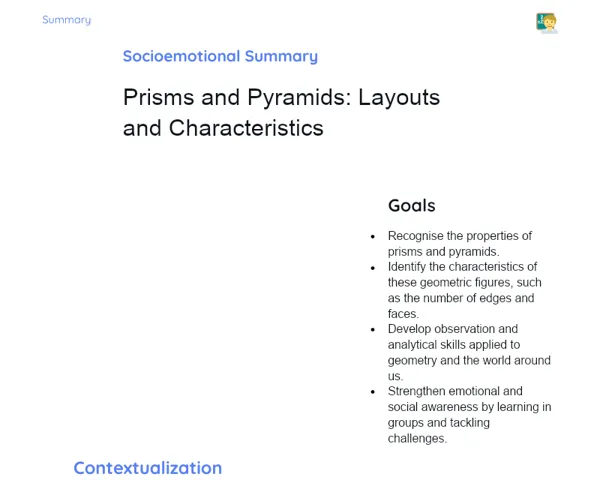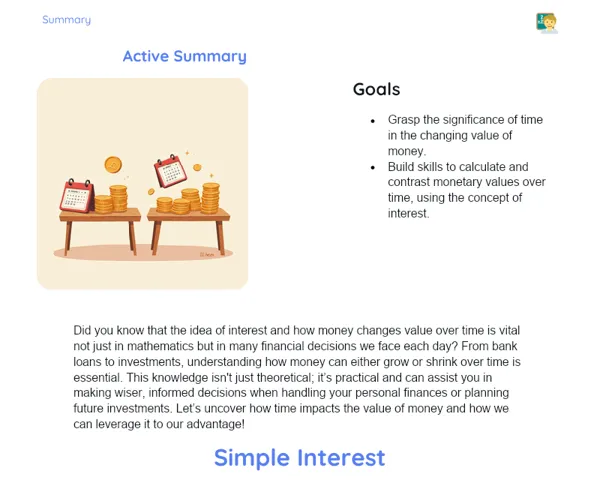Socioemotional Summary Conclusion
Goals
1. Recognise and visually identify the area of different objects.
2. Compare and classify objects based on their areas, determining which have a larger or smaller area.
3. Develop self-awareness and responsible decision-making skills when faced with mathematical challenges.
4. Learn to identify, understand, and manage emotions during the learning process.
Contextualization
Have you ever thought about how we choose the size of the bag we’re going to use or how we find the best spot to play outside? These choices involve comparing areas! Knowing how to measure and compare areas helps us make clever and practical decisions in our everyday lives. Let’s explore this together!
Exercising Your Knowledge
Definition of Area
The area measures the surface of an object. It helps us understand how big or small a space is and is crucial in various situations in our daily lives, like choosing a book that fits into a backpack or finding a comfy spot to sit in class. Comparing areas allows us to make informed and practical choices.
-
Area is measured in square units, such as square centimetres (cm²) or square metres (m²). This makes it simpler to compare areas of different sizes.
-
To calculate the area of rectangular shapes, we multiply the width by the height. This straightforward formula helps us grasp how sizes relate to each other.
-
Understanding area is vital for everyday tasks, like organising a backpack, where we need to determine what fits and what doesn’t in a limited space.
Units of Measure
We use different units of measure to calculate area, depending on the size of the objects we’re comparing. Knowing which unit to use helps us make accurate measurements, making our comparisons more effective and precise.
-
Square centimetres (cm²) are used for smaller areas, such as the surface of a book or a notebook.
-
Square metres (m²) are used for larger areas, like the space in a classroom or a playground.
-
Choosing the right unit is crucial to ensure our measurements are accurate and useful for the decisions we need to make.
Visual Area Comparison
Sometimes we can compare areas just by looking at them visually. This is particularly useful when we want to make quick estimations or when we don’t have tools to measure accurately. Visual observation helps us develop perceptual skills and gives us an initial sense of the sizes of objects.
-
Visual comparison allows us to make an initial guess at which object has a larger or smaller area, even without measuring precisely.
-
Using visual comparisons is a skill that aids us in everyday life, such as deciding where to place our materials in the classroom.
-
This skill also helps us foster a sense of proportion and space, which is essential for many practical and creative activities.
Key Terms
-
Area
-
Square Centimetres (cm²)
-
Square Metres (m²)
-
Visual Comparison
For Reflection
-
How did you feel when using visual comparison to determine the area of objects? Were you confident or did you have doubts?
-
During the activity of measuring areas with rulers and paper squares, was there a moment when you felt frustrated or happy? What caused those emotions?
-
How do you think being able to compare areas can help you in your day-to-day activities? Can you give an example?
Important Conclusions
-
We learned to identify and compare the areas of different objects, both visually and through actual measurements.
-
We recognised the importance of using suitable units of measure, such as square centimetres and square metres.
-
We developed socio-emotional skills while addressing mathematical challenges, acknowledging and managing our feelings during the learning process.
Impacts on Society
In our daily lives, the ability to compare areas is incredibly useful. For instance, when we decide where to store our school supplies in the cabinet or select the right size backpack, we are applying this skill. Furthermore, understanding and managing our emotions during these tasks helps us make more balanced and thoughtful decisions. Beyond our individual experiences, area comparison significantly impacts society in fields like urban planning and architecture. The ability to measure and compare areas is fundamental to designing efficient and functional spaces. Therefore, by acquiring these skills early on, we're preparing ourselves to make valuable contributions in various professional areas down the line.
Dealing with Emotions
To further enhance your emotional intelligence, I suggest a practical exercise. While studying area comparisons at home, pay attention to how you feel about the content – are you confident or anxious? Figure out why you might feel this way; is it because you find the topic daunting or straightforward? Accurately name your feelings, such as 'frustrated' or 'excited'. Share your feelings appropriately, perhaps by chatting with a friend or family member about your challenges. Finally, manage your emotions by taking a moment to breathe deeply if you feel overwhelmed and remember that learning is a continuous journey.
Study Tips
-
Create diagrams and drawings to visualise and compare areas of different objects. This makes learning more enjoyable and easier to comprehend!
-
Practice measuring areas with everyday objects at home, like books, notebooks, and boxes. This helps you apply what you learned in the classroom to your daily life.
-
Work in groups whenever possible. Sharing your thoughts and methods with classmates can offer new insights and make your practice more enriching.



